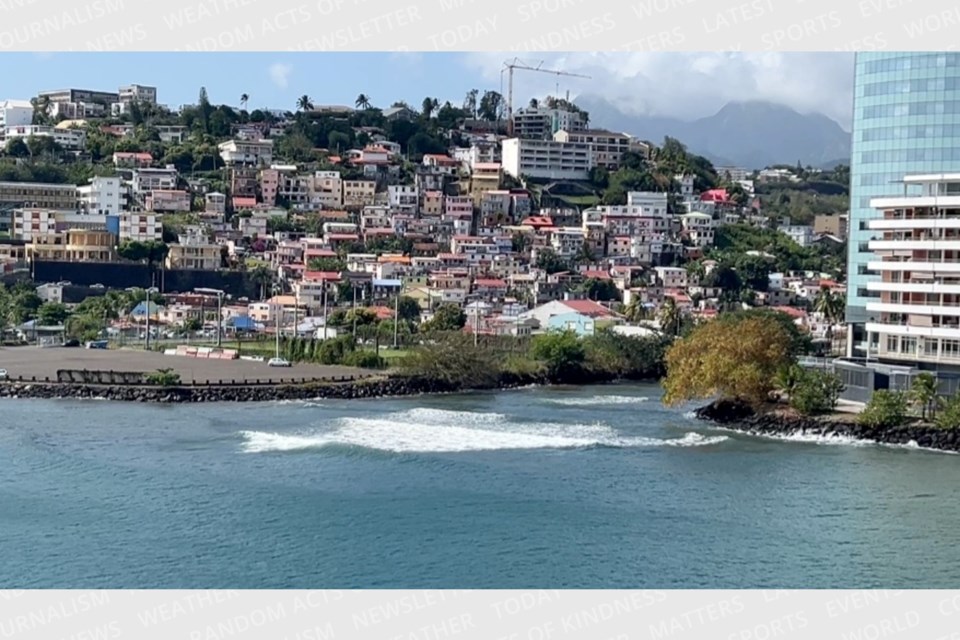The following is a column from BarrieToday community advisory board member Peter Bursztyn about his trip south of the equator. This is Part 9 in a series. To read the others, click on the following: Part 1, Part 2, Part 3, Part 4, Part 5, Part 6, Part 7 and Part 8.
From the sea, the capital of Martinique, Fort de France, looks like many Caribbean cities. It's a mixture of old and modern architecture in a seaside setting.
As soon as you step ashore, you can see a difference. First, the licence plates on the vehicles are “European,” because Martinique is an overseas “departement” of France, a full member of the European Union and uses the Euro currency.
The last point is important because it ensures a reliable banking system and protects islanders from inflation.
Walking the streets, one notices they are clean and well maintained. I saw a spotless fishmonger and a French bakery filled with baguettes and croissants. Except for the heat and humidity, you could be in a small French town.

Up a street, I spotted a large mural filling a wall. It appeared to show a humpback whale’s tail above the water just before a deep dive. Walking closer, I saw it was a plastic garbage bag loosely tied into the shape of a whale tail, a powerful statement against plastic pollution in the seas.
Making my way back to the ship, I saw a modern, three-section articulated bus, much like a modern Toronto tramcar. It was moving silently, clearly powered by electricity. Back aboard, I searched for information on Martinique’s electricity sources.
In 2011, 100 per cent of Martinique’s electricity came from diesel generators. It makes no sense to run a bus on diesel-generated electricity. It's more efficient to burn the fuel in the vehicle itself.
By 2018, seven per cent came from renewables. Five years later, more than half did.
Martinique expects its power grid to be 100 per cent energized by renewables by 2030.
Martinique grows cane, refining this into granulated sugar. After squeezing the cane for its sap, the dry residue is burned for energy to spin a generator. The waste heat from this process evaporates the juice to yield crystalline sugar. Existing installations make electricity to cover their internal needs, exporting about three times what they produce to the power grid.
By also using waste heat from power production, thermal efficiency will be high — probably over 80 per cent of the energy contained in their fuel. (A typical nuclear or coal power plant captures just 30 per cent of the fuel energy usefully, as does a gasoline-powered car; small diesel engines operate at 40 per cent, heavy trucks 45 per cent while large marine diesels reach 50 per cent.)
Since the fuel is crop biomass, this electricity is renewable. These generators operate continuously, making them particularly valuable; better than intermittent wind or solar power.
(Days later, I learned that the electric bus was actually a hybrid, running entirely on battery power in urban areas, using its diesel engine on leaving town. These buses actually operate like a railway without rails, circling the island to provide public transport.)
For comparison, the small island of Barbados is nearby. Barbados generates about 10 per cent of its electricity with renewables. Most of this is solar power from small individual (probably rooftop) installations.
Cuba is the largest island in the Caribbean. With its economy stifled by an oppressive government and six decades of American sanctions, Cuba’s electricity is still 95 per cent fossil-fuelled. Russia supplied Cuba’s oil for years until the USSR collapsed. This gave rise to Cuba’s “special period” featuring food and energy rationing.
In 2000, Venezuela began to supply Cuba with subsidized petroleum. By 2023, the Maduro government of Venezuela could no longer afford the subsidy and the price of Cuba’s gasoline suddenly soared five-fold.
Decades of cheap petroleum are probably the main reason why Cuba failed to build renewable energy generating facilities. Although Cuba is a major sugar producer few of their sugar refineries produce their own electricity, accounting for just 3.5 per cent of the island’s needs.
Wind energy has been very neglected (0.1 per cent of Cuba’s supply), considering the ready availability of steady easterlies in the region.
Jamaica, too, has been slow to embrace renewable power with over 80 per cent of electricity sourced from fossil fuels. Interestingly, around 25 per cent of Jamaica’s electricity is “unaccounted for,” meaning it's either lost during transmission (due to heating of transformers and wires; nine per cent of Canadian electricity is lost this way too), but more is “stolen” by users bypassing the meter.
This happens in other Caribbean islands. Many power poles in Brazil are also festooned with random wires attached by locals stealing electricity – at considerable danger to themselves. This is common practice in other developing countries like India and in southeast Asia.
Our last stop before the cruise ended in Miami was Puerto Rico. I was not sure what to expect here because the island is actually U.S. territory. Puerto Rico’s energy is derived overwhelmingly (about 90 per cent) from fossil fuels.
Sadly, Puerto Rico remains underdeveloped and has more in common with other Caribbean nations than with the continental United States.
In the Caribbean region, Costa Rica is renewable electricity’s poster child. This small country’s power grid is almost entirely (around 98 per cent) renewable. Hydroelectric installations (about 67 per cent) make good use of the moisture Costa Rica’s rain forests store and release gradually. Wind and geothermal generation produces most of the remainder.
Costa Rica’s unofficial slogan is “pura vida,” meaning pure life or simple life, and stands for their determination to preserve their environment and their natural heritage. Their electricity supply is evidence of their commitment to “pura vida.”
Surrounded by low income countries, Costa Rica is a middle-income country with average incomes roughly half those in the OECD (high income countries like France, Germany and Canada). They owe their relative prosperity to their lack of a standing army – often a major reason for unrest and poverty. Their commitment to renewable energy definitely plays a role, too.
These days, renewable energy is often the least costly source of electricity available. Even where it isn’t the cheapest, once you have installed the necessary equipment, since there is no “fuel,” the cost of the electricity produced from renewables is stable and predictable. Domestically derived, your energy infrastructure cannot be held to ransom.
The above makes one wonder why Canada’s carbon footprint is so large. We are a wealthy country and could afford to de-carbonize our economy more aggressively. Instead, we waste emotional energy battling NIMBY groups and shortsighted politicians, while led by timid politicians.
We Canadians need to wake up and take note of the strides being made by European countries, and by the world’s top carbon emitter, China.
It isn’t that we Canadians are responsible for a large percentage of the world’s carbon emissions; it’s about which country gets to nurture and host the industries our low carbon future will need. That should be us.



